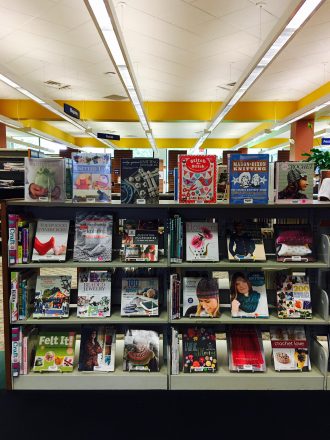Visual Merchandising – Applying Bookstore Insights to Public Library Collections

By Allison Marie Fiscus. About the Author: Allison Marie Fiscus is Manager of the Maumee Branch at Toledo Lucas County (OH) Public Library. Contact Allison at allison.fiscus@toledolibrary.org.
What if I told you that the more intricate and thought out a book display, the less likely it is that a customer will actually touch a book on it, let alone check one out? What if I said that at best an overly constructed book display discourages circulation and at worst contributes to its decline? Counterintuitive though it may be, it’s the truth.
Bookstores figured this out long ago. It’s one of the main reasons that in a world populated by Amazon shoppers they have stayed in business. Conversely, public libraries nationwide have seen their circulation drop steadily as new ways of consuming text come into popularity.1
Why is it that we struggle to give away materials for free while Barnes and Noble keeps their people coming back to give them more of their hard-earned dollars?
The answer is visual merchandising. It’s not just a tool for retail establishments. As a veteran of the bookstore industry I’ve seen it in action, and I’m here to tell my fellow librarians that we can learn from what they’ve spent millions of dollars to research and implement.
Keep It Simple
Don’t spend excessive amounts of time carefully creating a display based on a topical theme. Instead, curate displays based on a very general idea or genre. Mystery titles, biographies, juvenile fiction, holidays, cooking—pick your prettiest book covers or the titles you have in largest quantity and display them simply and prominently (more on this in a moment). These displays will be easy to refill and can be used to help struggling books circulate purely by being out in the open. And make no mistake; being able to refill your displays quickly is key. A full display is an inviting display and these books will go.
New Books Are “New” to Your Patrons Far Longer Than They Are to You
Dedicate a large space to prominently displaying new books with their covers facing out. If possible, keep books in this “new” section for at least twelve months. Consider this: per capita, U.S. library users visit a library less than five times a year.2 With that in mind, highlighting books as new for twelve months makes perfect sense and arguably is still not a sufficient amount of time for your customers to fully grasp what you have to offer. Make it easy on them to find new titles and they will reward your efforts with circs.
Take the Time to Study How Your Customers Move Through Your Library
Find an hour every day for a week and sketch a heat map of where your customers travel upon entering your building. The results may very well surprise you and will definitely help you to better understand where displays should be placed to support interaction. It’s easy to look at your library and see where you can fit a display, but if the majority of your customers are coming through the door, walking directly to the hold shelf/computers/quiet study, and back out the front door again, they aren’t seeing your display on the slat wall behind your fiction stacks. Put the books where the customers already are. Once you get their attention their user habits very well may change, at which point you can push displays into new and deeper areas of your space.
Get Creative (With Your Furniture)!
Extra table lying around? Display space! Short shelving units? Display space! Unused atlas stand? Display space! Before you commit to spending gobs of hard-won funding on new furniture and shelving to support your displays, take a hard look at what you have and what can be tastefully repurposed. Shift collections to different areas and don’t give valuable shelving real estate to collections that will circulate anyways. However, avoid using temporary furniture such as folding tables for display. Sadly, these look sloppy no matter how much work you put into making them presentable.
Set Simple Display Rules and Be Strict About Them
Straight lines and pyramids are your friend. If you take nothing else away from this article, let this be what sticks with you. The eye needs help to travel systematically through a display. Keep your lines straight wherever possible. Books should be fronted and even and the largest and heaviest-looking items
should be at the bottom. Faced-out books should be parallel to the edge of the shelf or table and even with each other. They should also reach their tallest point in the center and taper out. These are simple steps, but important ones. The organization of materials will be the most striking element of your display and the cleanliness of the line will invite interaction. Once your rules are set, be strict about them. A perfectionist’s eye is not a bad thing when applied to displays.
Absolutely No Props
Or tablecloths. Or clip art. Or scraps of fabric. They distract from the very things you are trying to give attention to and provide an unnecessary barrier the
patron and the materials. If your display looks like a sculpture, people will be afraid to touch it. Let the books display themselves. They will be stunning in their simplicity. The same is true for any signage you may use. Avoid overly decorated signs with small print and intricate font. Instead, develop a generic sign with a striking but simple background that can be changed easily and used across different displays. Choose a font that is bold and simple (Comic Sans and Curlz need not apply) and make it large enough to be seen from across the room. If you must use imagery keep it to one picture and make sure it’s large enough to fill the entire background.
Make Displays a Prominent Portion of Your Library
Walk through a Barnes and Noble or your local independent book store and take careful stock of how many and what type of items they have placed spine-out on a shelf. It’s less than you may think. That’s because they know that people rarely browse book spines for items to purchase. Traditional shelf space in bookstores exists to house the backlist titles that are most likely to be “needed” i.e. the classics and James Patterson. To promote their materials and increase sales, bookstores heavily face-out and display their wares. We should too. There’s a reason that book covers are beautiful and eye-catching: they are meant to be seen. And though the old adage may be true, we all totally judge books by their covers.
Maintain a Clean and Organized Library
Keeping your library clean is everyone’s job. Examine the typical routine of your employees’ day and look for ways to fit in structured “recovery” time. At least once a day, walk every aisle of your stacks and adjust any book that does not meet your display rules. When you see a shelf or display that has fallen into disarray, fix it immediately. This is a culture shift for many libraries but one of the most important steps that can be taken to positively affect circulation and your public’s perception of your library. Patrons can tell when librarians and support staff are proud of their collections. It’s my experience that this, more than anything, leads to increased enthusiasm for a library’s materials. It may seem trivial, but the work you put into your displays is just as important (and arguably more important) as the work you put into collection development. It’s not enough to carefully select a book for purchase if that book is destined to sit on a lonely corner of a far-off shelf. By developing a strategy and a set of rules that works for your materials, you are providing your customers with the ease of browsing they have come to expect as well as giving your collection the spotlight it deserves. Trust me, your customers and your circulation manager will thank you.
References
1. John B. Horrigan, “Libraries 2016: Library Usage and Engagement,” Pew Research Center, Sept. 9, 2016, accessed Dec. 14, 2017, www.pewinternet. org/2016/09/09/library-usage-andengagement.
2. Institute of Museum and Library Services, Public Libraries in the United States Survey Fiscal Year 2014 (Wash., DC: The Institute, Aug. 2017), accessed Dec. 14, 2017, www.imls.gov/sites /default/files/publications/documents /plsfy2014.pdf .















